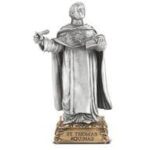
St. Thorfinn
St. Thorfinn
When they lived: St. Thorfinn of Norway lived during the 11th century, specifically from 1070 to 1115 AD.
Where they lived: St. Thorfinn lived in Norway, primarily in the northern regions of the country, during a time when Norway was still a collection of small kingdoms and chiefdoms.
Notable world events during the time of their life:
- The Norman Conquest of England (1066): St. Thorfinn’s lifetime saw one of the most significant events in medieval European history. William the Conqueror, Duke of Normandy, invaded England and established Norman rule, forever altering the course of English history.
- The Investiture Controversy (1075-1122): In the midst of Thorfinn’s life, the Investiture Controversy raged in Europe. This conflict between the papacy and secular rulers, particularly the Holy Roman Emperor, revolved around the appointment of bishops and church officials. It had profound implications for the relationship between church and state.
- The First Crusade (1096-1099): During St. Thorfinn’s lifetime, the First Crusade took place. Christian armies from Western Europe embarked on a holy mission to recapture Jerusalem from Muslim control. This marked the beginning of a series of Crusades that would shape European history and interactions with the Middle East.
- The Domesday Book (1086): In 1086, just a few years before Thorfinn’s birth, the Domesday Book was completed in England. This detailed survey of landholdings and resources provided invaluable insights into the socioeconomic conditions of medieval England.
Their Patronage: St. Thorfinn is the patron saint of Arctic Norway, particularly the regions of Tromsø and Finnmark. His life and sanctity are associated with the enduring Christian faith in the face of challenging northern climates and the spread of Christianity in the remote parts of Norway.
St. Thorfinn’s story is a remarkable blend of faith, resilience, and the historical context of his time. His dedication to Christianity in the harsh northern landscapes of Norway, set against the backdrop of significant world events, makes for a compelling narrative of a lesser-known medieval saint.
Early Life
Thorfinn was born in the city of Trondelag around the 1200s. It is suspected that he may have been a Cistercian monk before he was made Bishop of the Ancient Diocese of Hamar in medieval Norway. Only a few details can be gathered about Thorfinn, even if he’d been a popular saint to a reasonable extent. He lived a really low-profile life. St.Thorfinn is known to have lived a just life and to have stood up for only what was right. He is remembered as a good man whose goodness was joined with strength. A poem was written about him by Father Walter and left at his gravestone. He was named as a witness to the agreement of Tonsborg in the year 1277, which led to his being sent one hundred miles by King Eric.
Call to Dedication and Devotion
Because he was identified as a witness to the agreement of Tonsborg, he was exiled by King Eric (who was referred to at the time as Priesthater”), with claims that Thorfinn had supported the Archbishop of Nidaros by being a witness to the agreement. This support was in the case of the dispute that had occurred as a result of the state’s interference with the matters of the Church. On exile, Thorfinn found home in Flanders, in a Cistercian abbey. This act of injustice vested in him did not prevent him from continually doing good and standing for what was right.

It is believed that in his earlier years, St. Thorfinn had been a Cistercian monk before becoming the Bishop of Hamar. He had carried out both duties in service to humanity and God, most importantly. He was driven by love and passion for God to do good works.
Legacy
Knowing that his death was drawing near, the saint drafted a will in which he distributed his properties between his family and the church.
The Saint wasn’t intrigued by the pursuit of fame and recognition for his acts of goodness, generosity, patience, and aversion to evil; he was more focused on pleasing the Lord.
Death
Upon his return from exile, St. Thorfinn fell deeply ill and passed away as a result in the year 1285. His grave, discovered fifty years later, smelt pleasantly, and Father Walter’s poem to him, which hung on the gravestone, still felt very fresh. This miraculous display proclaimed Thorfinn’s holiness, and devotions to him soon spread around the Cistercian Church and Norway.
Feast Day
The feast day of St. Thorfinn is usually celebrated on the 8th day of January.
3 Interesting Facts About St. Thorfinn
- St. Thorfinn was exiled by King Eric for deciding to stand with the
Archbishop of Nidaros over an argument with the king. - On exile, St. Thorfinn took shelter in the abbey of Cistercia, and
did not stop doing good. - Did you know that fifty years after his death, St. Thorfinn’s grave,
which had been long forgotten still smelled pleasantly, and the
sheet on which Father Walter had written his poem to the saint
still appear fresh?
Prayer to St. Thorfinn
All-powerful and ever-living God, you called Saint Thorfinn to guide your people by his word and example. With him, we pray to you: watch over the pastors of your Church and the people entrusted to their care, and lead them to salvation. We ask this through our Lord Jesus Christ, your Son, who lives and reigns with you and the Holy Spirit, one God, forever and ever. Amen.
Source:[https://www.vitaesanctorum.wordpress.com/2014/01/08/st-thorfinn-bishop/amp/]{.ul}



